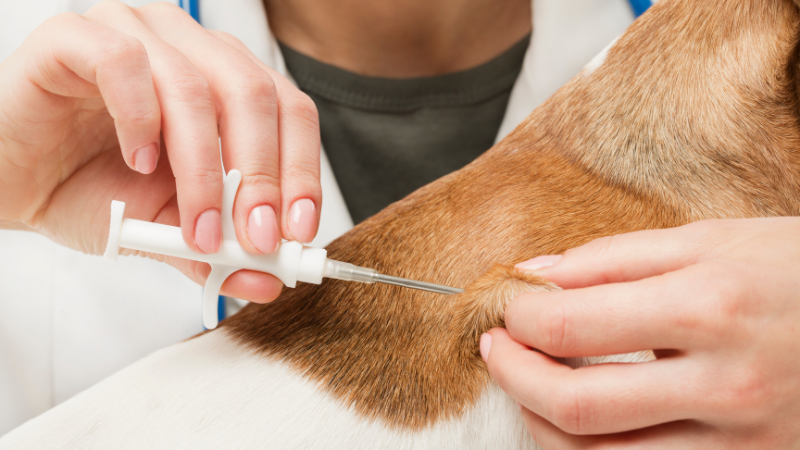This blog, Should You Microchip Your Dog? Pros, Cons, and FAQs, explores the pros and cons of microchipping your dog and provides helpful advice on whether or not it’s the right decision for you.
Microchipping is becoming increasingly popular for pet owners to provide easy access to information in the event of their pet getting lost or stolen.
However, microchipping has pros and cons, so it’s important to weigh all the options before making a decision. This blog looks at the pros and cons of microchipping your dog and provides helpful advice on whether or not it’s the right decision for you.
What Is Microchipping?
Pet ownership is a privilege that comes with great responsibility. One of the responsibilities is being able to quickly reunite your lost pet. That’s where microchipping comes in – a simple and effective way to do just that.
A microchip is a miniature electronic chip approximately the size of a grain of rice and housed in a glass cylinder. The chip does not include a battery.
The microchip is activated by a microchip scanner that passes over the area, and the radio waves the scanner produces activate it. The identification number is transmitted to the scanner, which shows it on a display screen. With that information, the registry is revealed and the owner can be contacted.
The Procedure

Microchips are usually inserted under the skin between the shoulder blades in dogs using a hypodermic needle. No surgery or anesthesia is required and the process generally takes less than 10 minutes.
Microchipping is a relatively painless process that can be done at an approved vet clinic or animal hospital.
What Information Is On The Microchip?
The only information on the chip is the name of the registry associated with the chip. With that information, the vet or animal shelters can call the registry and get only the information you provided, such as phone number or emergency contact. If your dog is lost and then found and the chip scanned, the information you provided to the registry will be used to contact you.
Is It Cruel To Microchip A Dog?
While some people believe that microchipping a dog is cruel, others argue that it is a necessary step in their pet’s safety.
What Are The Risks Of Microchipping Your Dog?
There is no consensus on the long-term effects of microchipping. Many proponents of microchipping believe that it is relatively safe and does not cause any long-term adverse side effects.
A 2017 review of the evidence found that “the overall findings suggest that microchipping does not usually cause substantial adverse effects.”
However, there is some debate as to whether microchipping can actually harm dogs.
The adverse reactions to microchips, as reported by the American Veterinary Medical Association, are recorded in the British Small Animal Veterinary Association (BSAVA) database. Almost 4 million animals have been microchipped since the database’s inception in 1996, and just 391 adverse events have been documented.
Some scientific studies have found that the implantation process can cause pain and inflammation. There have been a few cases where microchipped animals have later developed cancer or other health problems.
The most prevalent difficulty reported is the microchip moving from its original placement site. Failure of the microchip, hair loss, infection, swelling, and tumor development were all reported in far smaller numbers.
So, while this technology may be harmless on average, it’s always important to consult your veterinarian before getting your dog chipped.
Pros Of Microchipping Your Dog
One of the first things that happens when a lost animal is brought to an animal shelter or veterinary clinic it is scanned for a microchip. This can instantly identify the animal’s owner if a microchip is found and the microchip registry has up-to-date information.
By scanning chips, they can help the staff determine whether the animal has been legitimately adopted or stolen and take appropriate action (as needed). In some cases, scanned data from implanted devices may even be used to prosecute criminals.
While many people view microchips as a sort of “spy” technology that violates our privacy rights, studies have shown that overall rates of theft and injury involving pets have declined since microchipping became more widespread.
In fact, one study showed that it was almost 100% effective at recovering stolen animals. So while some initial discomfort might be associated with having your dog chipped for this purpose, remember what ultimately benefits everyone involved: safe, reunited homes for our furry friends!
Video: Science Behind Your Pet’s Microchip
Cons Of Microchipping Your Dog
There are some cons to microchipping your dog. For example, if your dog gets lost, the microchip implant won’t always be the best way to find them. This is because someone who finds your dog would need to take him to a vet to be scanned for the microchip.
Additionally, some health risks are associated with microchipping, most notably around sterilization procedures and the insertion of a wire into the dog’s body.
The most common con is that the chip can get lost. If this happens, locating your pet without proper identification may be challenging.
In addition, if your pet becomes lost and lives in an area without databases, they could be unable to find their way home!
What Happens If My Microchipped Pet Gets Lost?

If your dog gets lost best case scenario is the person who finds him takes him to the vet or shelter. Once there, one of the first things that happens is using a microchip scanner (like the one shown to the right) the animal is scanned for a microchip.
If they discover a microchip, this can instantly identify the animal’s owner. This, of course, is dependent on the microchip registry having up-to-date information. This is why it is so important to keep the registry information current.
This is done free of charge, so the person who finds the dog isn’t burdened with a vet bill.
According to research reported by the American Veterinary Medical Association, “A study of more than 7,700 stray animals at animal shelters showed that dogs without microchips were returned to their owners 21.9% of the time, whereas a pet microchipped were returned to their owners 52.2% of the time. ”
Most of the time, it was due to incorrect owner information in the database that a chipped dog was unable to be reunited with its family. So again, it’s so important to be sure to update your contact information with the registry.
For more information about traveling with dogs, see: The Ultimate Guide To Traveling With Dogs
FAQs About Microchipping
How Much Does It Cost To Get My Dog Microchipped?
There is no one-size-fits-all answer to this question, as the price of microchipping will vary depending on your location and which type of chip is required.
However, ballpark figures for a small dog residing in North America range from $25-$200, with some pet insurance companies covering the procedure completely.
It is important to note that not all pet insurance plans cover this procedure, so it may be necessary to pay out-of-pocket.
When I got my dogs microchipped, it was $25.00 each, so check around. Just be sure you are dealing with a reputable company.
Why Do I Have To Register My Dog’s Microchip?
By registering your dog’s microchip, you can ensure that they are easier to find if they go missing and more likely to be returned home.
The chip is only as good as the information that has been provided to the registry for them to contact you. If you don’t register the chip, it’s just something inside your dog’s body. It doesn’t automatically know how to find you.
If you’ve moved or any of your information (especially your phone number) has changed, make sure you update your microchip registration in the manufacturer’s database as soon as possible.
Is There Any Maintenance Needed For The Microchip?
These chips can last up to 10 years without needing replacement, making them ideal for long-term use.
Only three things you need to do after your pet is microchipped:
- Make sure the microchip is registered.
- At a routine veterinary office visit, ask your veterinarian to scan your pet’s microchip. This should be done at least once a year to confirm that the chip is still working and can be found.
- Keep your registration information current.
Popular Posts
Conclusion
As we found in, Should You Microchip Your Dog? Pros, Cons, And FAQs, while microchip implantation does not guarantee that your pet will be returned if it is missing or stolen, it substantially raises the odds of your being reunited with your pet…assuming you keep the registration information current.
Keep in mind that the pros and cons of microchipping your dog are personal preference based, so make sure to research each option carefully before making a decision.
In the meantime, feel free to drop a comment below with any additional questions you may have! We would love to help you out!



